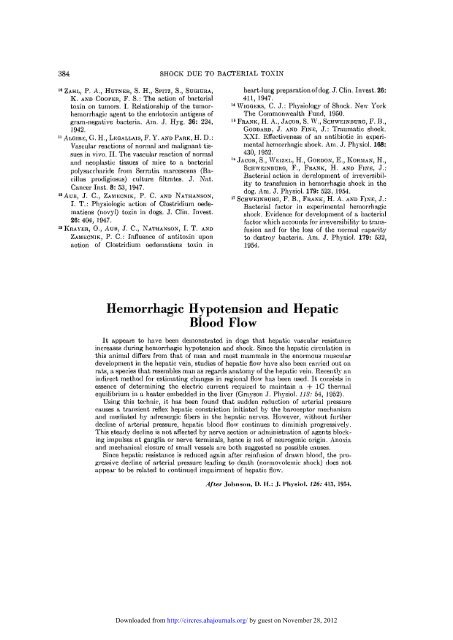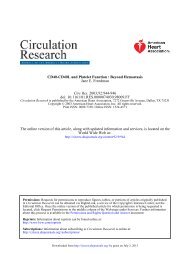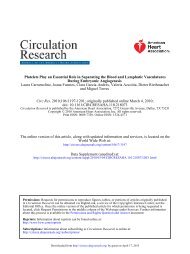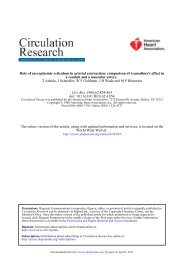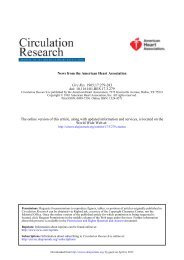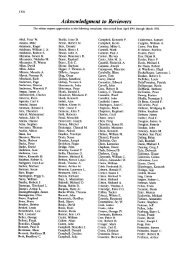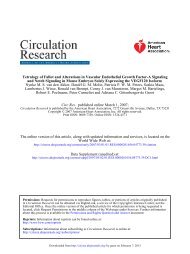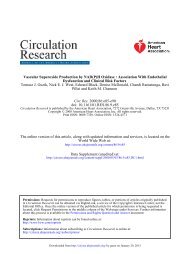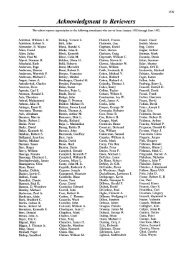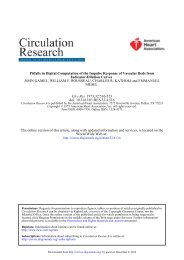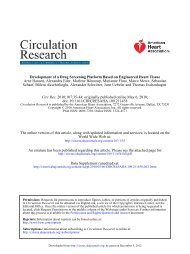RICHARD V. EBERT, CRAIG W. BORDEN, WENDELL H. HALL and ...
RICHARD V. EBERT, CRAIG W. BORDEN, WENDELL H. HALL and ...
RICHARD V. EBERT, CRAIG W. BORDEN, WENDELL H. HALL and ...
You also want an ePaper? Increase the reach of your titles
YUMPU automatically turns print PDFs into web optimized ePapers that Google loves.
384 SHOCK DUE TO BACTERIAL TOXIN<br />
10 ZAHL, P. A., HUTNER, S. H., SPITZ, S., SUGIURA,<br />
K. AND COOPER, F. S.: The action of bacterial<br />
toxin on tumors. I. Relationship of the tuniorhemorrhagic<br />
agent to the endotoxin antigens of<br />
gram-negative bacteria. Am. J. Hyg. 36: 224,<br />
1942.<br />
11 ALGIRE, G. H., LKQALLAIS, F. Y. AND PARK, H. D.:<br />
Vascular reactions of normal <strong>and</strong> malignant tissues<br />
in vivo. II. The vascular reaction of normal<br />
<strong>and</strong> neoplastic tissues of mice to a bacterial<br />
polysaccharide from Serratia marcescens (Bacillus<br />
prodigiosus) culture filtrates. J. Nat.<br />
Cancer Inst. 8: 53, 1947.<br />
U AUB, J. C, ZAMECNIK, P. C. AND NATHANSON,<br />
I. T.: Phj-siologie action of Clostridium oedematiens<br />
(novyl) toxin in dogs. J. Clin. Invest.<br />
26: 404, 1947.<br />
"KRAYER, 0., AUB, J. C, NATHANSON, I. T. AND<br />
ZAMECNIK, P. C: Influence of antitoxin upon<br />
action of Clostridium oedematiens toxin in<br />
heart-lung preparation of dog. J. Clin. Invest. 26:<br />
411, 1947.<br />
" WIGGERS, C. J.: Physiology of Shock. New York<br />
The Commonwealth Fund, 1950.<br />
16 FRANK, H. A., JACOB, S. W., SCHWEINBURG, F. B.,<br />
GODDARD, J. AND FINE, J.: Traumatic shock.<br />
XXI. Effectiveness of an antibiotic in experimental<br />
hemorrhagic shock. Am. J. Physiol. 168:<br />
430, 1952.<br />
lb JACOB, S., WEIZEL, H., GORDON, E., KORMAN, H.,<br />
SCHWEINBURG, F., FRANK, H. AND FINE, J.:<br />
Bacterial action in development of irreversibility<br />
to transfusion in hemorrhagic shock in the<br />
dog. Am. J. Physiol. 179: 523, 1954.<br />
17 SCHWEINBURG, F. B., FRANK, H. A. AND FINE, J.:<br />
Bacterial factor in experimental hemorrhagic<br />
shock. Evidence for development of a bacterial<br />
factor which accounts for irreversibility to transfusion<br />
<strong>and</strong> for the loss of the normal capacity<br />
to destroy bacteria. Am. J. Physiol. 179: 532,<br />
1954.<br />
Hemorrhagic Hypotension <strong>and</strong> Hepatic<br />
Blood Flow<br />
It appears to have been demonstrated in dogs that hepatic vascular resistance<br />
increases during hemorrhagic hypotension <strong>and</strong> shock. Since the hepatic circulation in<br />
this animal differs from that of man <strong>and</strong> most mammals in the enormous muscular<br />
development in the hepatic vein, studies of hepatic flow have also been carried out on<br />
rats, a species that resembles man as regards anatomy of the hepatic vein. Recently an<br />
indirect method for estimating changes in regional flow has been used. It consists in<br />
essence of determining the electric current required to maintain a + 1C thermal<br />
equilibrium in a heater embedded in the liver (Grayson J. Physiol. US: 54, 1952).<br />
Using this technic, it has been found that sudden reduction of arterial pressure<br />
causes a transient reflex hepatic constriction initiated by the baroceptor mechanism<br />
<strong>and</strong> mediated by adrenergic fibers in the hepatic nerves. However, without further<br />
decline of arterial pressure, hepatic blood flow continues to diminish progressively.<br />
This steady decline is not affected by nerve section or administration of agents blocking<br />
impulses at ganglia or nerve terminals, hence is not of neurogenic origin. Anoxia<br />
<strong>and</strong> mechanical closure of small vessels are both suggested as possible causes.<br />
Since hepatic resistance is reduced again after reinfusion of drown blood, the progressive<br />
decline of arterial pressure leading to death (normovolemic shock) does not<br />
appear to be related to continued impairment of hepatic flow.<br />
After Johnson, D. H.: J. I'hysiol. 126: 413, 19.S4.<br />
Downloaded from<br />
http://circres.ahajournals.org/ by guest on November 28, 2012


